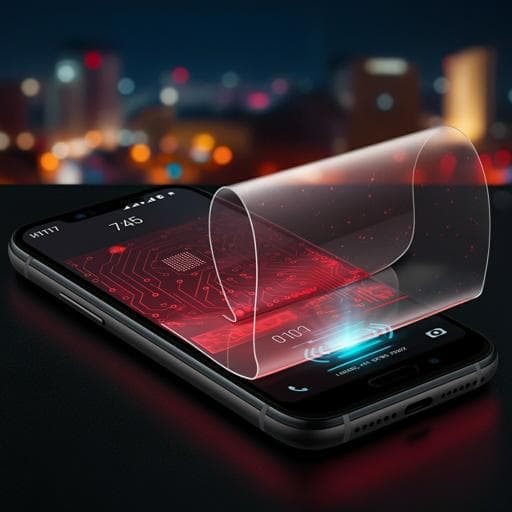
Engineering and Technology
Transparent near-infrared perovskite light-emitting diodes
C. Xie, X. Zhao, et al.
This groundbreaking research reports on the development of a transparent perovskite light-emitting diode (LED) that emits near-infrared light, perfect for enhancing mobile and wearable devices without sacrificing display space. Conducted by Chenchao Xie, Xiaofei Zhao, Evon Woan Yuann Ong, and Zhi-Kuang Tan from the National University of Singapore, this innovation showcases over 55% average transmittance in the visible spectrum.
~3 min • Beginner • English
Introduction
Research on perovskite electroluminescence has progressed rapidly, with device efficiencies improving from below 1% to over 20% in recent years. Near-infrared (NIR) perovskite LEDs (PeLEDs) are particularly successful, combining high efficiency, good reproducibility, and respectable operational lifetimes, including in large-area and flexible formats. While perovskites can be fabricated over large areas on diverse substrates—attractive for display applications—the conventional uses of NIR LEDs (covert illumination, security, optical communications) have limited utility if realized only as large-area emitters. This work addresses the challenge of integrating NIR emission unobtrusively into space-constrained consumer devices by realizing a transparent, large-area NIR-emitting PeLED that can overlay existing color displays, thereby enabling covert illumination and sensing without consuming additional device real estate.
Literature Review
Early PeLEDs achieved external quantum efficiencies (EQEs) around 0.8%, progressing to over 20% in later reports, reflecting advances in materials and device engineering (refs. 1–11). NIR PeLEDs have stood out for their reproducibility and stability compared to other spectral ranges. Large-area devices with uniform emission have also been demonstrated on rigid and flexible substrates (ref. 11). Compared to III–V chip LEDs, perovskites can be deposited over large, diverse substrates, similar to OLEDs and QD-LEDs. For transparent electrodes, sputtered ITO is widely used in perovskite photovoltaics, including semi-transparent cells employing nanoparticle buffer layers and sputtered ITO (refs. 12, 13). ITO/Ag/ITO multilayers are known for achieving very low sheet resistance with high transparency (ref. 14). However, for thin PeLED stacks, sputtering-induced plasma damage can create sub-gap defects and leakage paths, necessitating electrode designs that mitigate such damage while maintaining conductivity and transparency.
Methodology
Device architecture: ITO/AZO/PEIE/FAPbI3/poly-TPD/MoO3/Al/ITO/Ag/ITO. The top transparent electrode comprises Al (10 nm)/ITO (40 nm)/Ag (10 nm)/ITO (40 nm), designed for low sheet resistance, high transparency, and reduced plasma damage.
Perovskite precursor preparation: Dissolve FAI (27.7 mg), PbI2 (33.2 mg), and 5-AVA (7.7 mg) in 1 mL anhydrous DMF. Stir for 2 h at 80 °C in a nitrogen glovebox.
Substrate cleaning and preparation: Use pre-patterned ITO-glass substrates (8 Ω/sq). Sequentially ultrasonicate in detergent, deionized water, acetone, and isopropanol (10 min each), dry with N2, and UV-ozone treat for 15 min.
Electron-injection layers: Spin-coat AZO nanoparticles (2.5 wt% in IPA) at 5000 rpm for 1 min; anneal at 140 °C for 10 min. After cooling, spin-coat PEIE (0.4 wt% in 2-methoxyethanol) at 5000 rpm for 1 min; anneal at 110 °C for 20 min.
Perovskite layer: In N2 glovebox, dispense 80 µL of perovskite precursor and spin at 3000 rpm for 1 min; anneal at 100 °C for 16 min to form ~40 nm perovskite platelets.
Hole-transport and interfacial layers: Spin-coat poly-TPD (13 mg mL−1 in chlorobenzene). Thermally evaporate MoO3 (10 nm) and Al (10 nm) sequentially through a shadow mask at <1×10−6 Torr.
Top transparent electrode deposition: Transfer to sputtering system. Deposit ITO in two 40 nm layers at room temperature by pulsed DC magnetron sputtering (In2O3:SnO2 97:3 wt% target), gas flow 205 sccm (Ar:O2 98:2), DC power 2 kW. Deposit Ag interlayer (10 nm) by thermal evaporation at <1×10−5 Torr between the ITO layers. Device area is 120 mm2, defined by overlap of substrate ITO and Al/ITO/Ag/ITO.
Electrical/optical characterization: Measure J–V with a Keithley 2450 (0–5 V, 0.1 V steps, 1 s delay). Simultaneously record photon flux using a calibrated 100 mm2 Hamamatsu Si photodiode at 110 mm distance; record EL spectra with an Ocean Optics Flame-T spectrometer. Assume Lambertian emission to calculate EQE. Measure front (substrate side) and back (top electrode side) emissions in separate J–V sweeps using identical settings; minor degradation may occur during the first sweep. Measurements performed in a dark enclosure in an argon glovebox. Capture NIR images using an IR-modified Canon 200D DSLR.
Transmittance spectroscopy: Measure transmittance of devices and electrodes on glass using Ocean Optics HL-2000 light source with calibrated Flame-T spectrometer; for electrodes on glass, also use Agilent CARY-7000 spectrophotometer.
Comparative electrode studies: Fabricate and compare devices with different back electrodes: Al/ITO/Ag/ITO; thick ITO (500 nm); ITO/Ag/ITO (40/10/40 nm); opaque Al (80 nm). Evaluate J–V leakage, radiance, and turn-on behavior; note nominal sheet resistances: Al/ITO/Ag/ITO ~110 Ω/sq; ITO (500 nm) ~30 Ω/sq; ITO/Ag/ITO ~100 Ω/sq.
Key Findings
- Demonstrated transparent NIR PeLED with architecture ITO/AZO/PEIE/FAPbI3/poly-TPD/MoO3/Al/ITO/Ag/ITO and large active area of 120 mm2 (15 × 8 mm).
- Emission peak at 799 nm; device turn-on at ~1.5 V indicating efficient carrier injection.
- Radiance: Front emission up to 2.8 W sr−1 m−2 and back emission 1.2 W sr−1 m−2 at 4.0 V.
- External quantum efficiency: 4.5% (front) and 1.2% (back), giving total EQE of 5.7% at J = 5.3 mA cm−2 with total radiance of 1.5 W sr−1 m−2.
- Across 17 devices, average max-EQE: 3.5% (front) and 1.2% (back).
- High average optical transmittance >55% in 450–650 nm range; relatively flat transmittance across visible and NIR for Al/ITO/Ag/ITO devices, enabling overlay on color displays with neutral color appearance.
- Al/ITO/Ag/ITO top electrode design reduces sputtering-induced plasma damage relative to directly sputtered ITO or ITO/Ag/ITO on organic/perovskite layers, significantly lowering leakage currents while maintaining transparency and acceptable sheet resistance (~110 Ω/sq).
- Devices with 500 nm ITO or ITO/Ag/ITO back electrodes exhibit 2–3 orders-of-magnitude higher leakage current before turn-on and lower radiance, attributed to sub-gap defect formation from sputtering damage.
- The Al interlayer likely acts as both a physical barrier and an electrical shield during sputtering, mitigating charge build-up and breakdown.
- Operational lifetime: Transparent PeLED T50 ≈ 4 min (shorter than opaque counterparts), likely due to residual sputter-induced damage.
- Proof-of-concept application: Transparent PeLED overlaid on a smart-watch display shows high transparency in visible images and bright NIR electroluminescence under NIR imaging, masking underlying display—demonstrating covert illumination suitability.
Discussion
The study addresses how to realize a transparent NIR PeLED that can be integrated over existing displays without sacrificing visual transparency while delivering efficient NIR emission for covert illumination and sensing. The core challenge—plasma damage from sputtering transparent electrodes onto thin organic/perovskite layers—was mitigated by introducing a thin Al interlayer within a multilayer Al/ITO/Ag/ITO electrode. This approach preserves low sheet resistance and transparency while reducing creation of sub-gap defect states that cause leakage and reduce efficiency. The resulting devices exhibit low turn-on voltage (~1.5 V), respectable total EQE (5.7%), and high radiance, adequate for battery-powered wearables. Their >55% average transmittance across 450–650 nm ensures minimal impact on display color/contrast. Demonstrations on a smart-watch validate the concept of overlaying covert NIR illumination directly on displays to enable features like facial recognition, eye tracking, and depth sensing in space-constrained devices. Although the lifetime is currently short, the electrode strategy establishes a pathway to transparent, efficient NIR PeLEDs compatible with consumer electronics.
Conclusion
This work demonstrates a transparent, large-area NIR perovskite LED that can be overlaid on color displays, achieving 799 nm emission, total EQE of 5.7% at modest current density, high radiance, and >55% average visible transmittance. The multilayer Al/ITO/Ag/ITO top electrode with a protective Al interlayer effectively balances transparency, conductivity, and reduced sputter-induced damage, enabling efficient operation in a transparent form factor. A proof-of-concept integration on a smart-watch illustrates potential for covert illumination and sensing without additional device real estate. Future work could focus on improving operational stability and lifetime (e.g., further mitigating plasma damage, optimizing sputtering conditions and barrier layers), reducing leakage currents, and refining electrode stacks to lower sheet resistance while maintaining high transparency.
Limitations
- Short operational lifetime (T50 ≈ 4 min) for transparent devices, inferior to opaque PeLEDs, likely due to residual plasma damage from ITO sputtering.
- Higher leakage current than opaque Al-electrode devices, indicating remaining defect formation.
- Back-side emission is weaker than front emission due to higher optical losses/reflections in the multilayer top electrode.
- Potential device degradation during initial measurement sweep noted by the authors.
Related Publications
Explore these studies to deepen your understanding of the subject.







